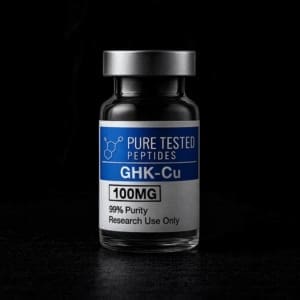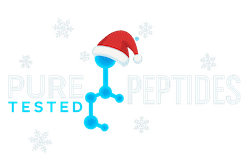Topical GHK-Cu (Copper Tripeptide): Mechanisms & Research Evidence
This page summarizes peer-reviewed findings on the topical application of GHK-Cu for skin biology—covering mechanisms (extracellular matrix remodeling, antioxidant/anti-inflammatory activity, and repair signaling), skin permeation data, and clinical/translational studies. It does not provide human dosages or usage regimens and avoids therapeutic claims.
What is GHK-Cu?
GHKCopper peptide
Glycyl-L-histidyl-L-lysine (GHK) is a naturally occurring human tripeptide that chelates copper (GHK-Cu). Reviews describe it in plasma and other fluids with age-related decline, and identify roles in tissue remodeling and repair signaling (PubMed; PMC).
How Topical GHK-Cu May Work (Mechanisms)
1) Extracellular matrix (ECM) remodeling
In vitro, ex vivo, and small clinical contexts, GHK-Cu has been reported to support collagen I/III, elastin, and glycosaminoglycan synthesis and to modulate MMP/TIMP activity—pathways central to dermal structure and resilience (PubMed; PMC; PMC).
2) Anti-inflammatory and antioxidant actions
GHK-Cu is discussed as a modulator of inflammatory signaling and oxidative stress in cell and animal models, with reports of reduced ROS and improved redox balance—mechanisms relevant to photoaging and wound environments (PMC).
3) Pro-repair signaling & cellular communication
Reviews summarize upregulation of genes associated with wound healing, angiogenesis, and keratinocyte/fibroblast activity, consistent with roles in skin repair biology (PMC; PMC).

Evidence From Preclinical & Clinical Studies
A) Skin permeation & bioavailability
- In-vitro penetration: A Franz-cell model showed human skin penetration of GHK-Cu in vitro, supporting the feasibility of topical delivery (PMC).
- Delivery enhancers: Microneedle pretreatment increased GHK-Cu penetration in a preclinical study (PubMed); liposomal carriers have also been reported to improve retention/transport (PMC).
- Permeability reviews: Recent reviews summarize permeation strategies for GHK-Cu and related analogs (PubMed; PMC).
B) Human skin & translational findings
- Post-procedure care: In a randomized regimen after CO2 laser resurfacing, a copper-tripeptide complex arm was assessed for erythema and appearance over 12 weeks (n≈20s) (PubMed).
- Dermal protein expression: Reviews citing biopsy-based work report increased collagen markers after topical GHK-Cu versus comparator creams in small cohorts, though methodologies vary and more robust trials are warranted (PMC; PMC).
- Adjunct synergies: Ex vivo/cell studies note synergy between GHK-Cu and hyaluronic acid on collagen IV (and I/VII) generation, suggesting formulation-level complementarity (PubMed).
C) Broader dermatologic context
Independent of brand or product, literature on copper in skin care describes roles in enzymatic cofactors, barrier support, and ECM maintenance; GHK-Cu is frequently highlighted among copper species studied for cosmetic dermatology. Findings remain heterogeneous across models and study sizes, so additional controlled human studies are encouraged (PMC).
Formulation & Skin-Delivery Considerations (No Dosing Guidance)
- Carriers: Liposomes and other vesicular systems may improve skin retention/penetration of hydrophilic peptides like GHK-Cu (PMC).
- Permeation techniques: Microneedles and topical permeation enhancers have been studied to increase delivery, though translation to routine cosmetic use requires safety and regulatory evaluation (PubMed; PubMed).
- Combination ingredients: Hyaluronic acid has shown synergistic effects with GHK-Cu on collagen IV in controlled lab settings (PubMed).
Research-Focused FAQ
Does this page recommend how to use GHK-Cu?
No. This article is for informational purposes only and does not provide usage instructions or dosages.
Is GHK-Cu the same as “copper” in skincare?
GHK-Cu is a specific tripeptide complexed with Cu(II). Literature differentiates peptide-bound copper from inorganic salts; biological activity depends on the complex and formulation (PMC).
How strong is the human evidence?
There are small clinical and post-procedure studies and multiple reviews. Many findings are from cell/ex vivo/animal models. Larger, well-controlled human trials would strengthen conclusions (PMC; PMC).
Selected References (PubMed/PMC)
- Pickart et al. GHK Peptide as a Natural Modulator of Multiple Cellular Pathways (2015) — review (PMC | PubMed)
- Borkow. Using Copper to Improve the Well-Being of the Skin (2014) — review (PMC)
- Pickart et al. Regenerative and Protective Actions of the GHK-Cu Peptide (2018) — review (PMC)
- Hostynek et al. Human Skin Penetration of a Copper Tripeptide (2010) — in-vitro permeation (PMC)
- Li et al. Microneedle-Mediated Delivery of Copper Peptide (2015) (PubMed)
- Miller et al. Effects of Topical Copper Tripeptide After CO2 Laser Resurfacing (2006) (PubMed)
- Dymek et al. Liposomes as Carriers of GHK-Cu (2023) (PMC)
- Jiang et al. Synergy of GHK-Cu and Hyaluronic Acid on Collagen IV (2023) (PubMed)
- Dou et al. The Potential of GHK as an Anti-Aging Peptide (2020) (PMC)
